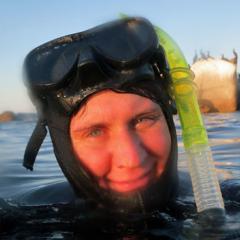Jennifer O'Leary Seeking Funding on RocketHub for Coral Reef Project
Editor's Note: 2006 Fellow Jennifer O'Leary is using RocketHub, a crowd-sourcing platform to raise money for research, for her coral reef fish project. Below is the synopsis of the project from the site, but this link will take you to the full page about the project, including a three-minute video: http://www.rockethub.com/projects/7521-where-have-all-the-coral-reef-fish-gone. She would appreciate it if you could forward the link to help her spread the word about the project. She can be reached directly at joleary@ucsc.edu.
Where have all the coral reef fish gone?
Coral reefs are one of the most threatened ecosystems world wide. This project collects critical data for the Kenya Wildlife Service to promote effective coral reef conservation and management of marine protected areas.
Reefs protect shorelines and prevent erosion of coastal properties and provide food and income to over 100 million people worldwide. Overfishing strongly contributes to the loss of reefs. Reef loss in turn, contributes to loss of biodiversity, economic decline, coastal destabilization, and loss of other nearshore habitats such as mangroves and seagrass beds.
Marine protected areas (MPAs) are one of the major ways by which we can protect coral reefs. MPAs allow fished populations to recover and protect the corals that build reef structure. Kenya is one of the four African nations (and one of the few developing nations worldwide) that has established and maintained MPAs where fishing has been excluded.
The Kenya Wildlife Service manages the four MPAs in Kenya and has identified a major problem in its most urban MPA in Mombasa. The Mombasa MPA has not fully recovered from fishing even though it has now been closed for over 20 years. A very important predatory fish is still found in relatively low numbers in the park. This predator, the triggerfish, is important because it eats spiny sea urchins (invertebrate grazers) which destroy corals when they graze. The triggerfish has recovered in the other three MPAs in Kenya and virtually eliminated sea urchins in those parks. The Kenya Wildlife Service is concerned that the small size of the Mombasa park, and its proximity to an urban center with heavy fishing, mean that the triggerfish move beyond park boundaries and are fished.
Dr. Jennifer O’Leary completed her Ph.D. and postdoctoral research in Kenyan MPAs and has been asked to help determine movement patterns of the triggerfish. This project will tag the population of triggerfish within the Mombasa Marine Park, and retrieve the tags from fishermen along with information on where any tagged fish were caught.
The money donated to this project will support the costs of fish traps to capture the triggerfish, the tagging equipment and small printed tags, costs of fuel for boats for tagging and field surveys on the numbers of triggerfish present, and rewards for fishermen who turn in tags.
If the project funding goal is not reached, the money raised will still go toward this effort by helping purchase research equipment and field time that can be used by the Kenya Wildlife Service in their monitoring and management efforts. For example, $500 allows the purchase of the tags and tagging equipment. $1000 allows tagging equipment plus the costs of boat fuel, and fish trap rental. $1,500 allows all of the previous things, plus small rewards for fishermen to encourage return of tags. $2,000 supplies all the previous and allows for hiring local field assistants to make the tagging proecess more efficient. $2,600 will allow field and boat time (and fuel) to conduct surveys of the reefs for triggerfish and sea urchin abundance that will complement the data from the tagging efforts.
The resulting data will directly inform if overfishing around park boundaries is preventing full recover of the Mombasa MPA ecosystem. Results of this research will be used directly for management decision making, which may include increasing the size of the Mombasa Marine Park or developing greater restrictions on fishing of this species in areas adjacent to the park.
